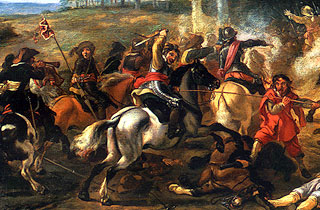|
From his country’s
adventures/misadventures a few years earlier in Poland and Russia, King Gustavus
Adolphus had witnessed his enemy’s cavalry fight as of old, which most likely
inspired him to have his cavalry emulate their eastern enemies.
“Cavalry played an important role in battle and campaigning. The Poles won
cavalry victories over the Swedes at Kokenhausen (23 June 1601), Reval (June
1602), Kirchholm (27 September 1605) and, over a much larger Russo-Swedish army,
at Klushino (4 July 1610)… At Kirchholm and Klushino, the mobility and power of
the Polish cavalry, which attacked in waves and relied on shock charges,
nullified its opponent’s numerical superiority and the Poles were able to
destroy the Swedish cavalry before turning on their infantry. Exposed once the
cavalry had been driven off, the Swedish infantry suffered heavily…"
pg. 123: European Warfare, 1494-1660, by Jeremy Black, Routledge, 2002
 In addition, the
king knew
about the
reforms of Henri IV of France that
began in 1585 for organizing cavalry into squadrons, substituting swords
and pistols for lances, but still aggressively charging. In addition, the
king knew
about the
reforms of Henri IV of France that
began in 1585 for organizing cavalry into squadrons, substituting swords
and pistols for lances, but still aggressively charging.
As with Henri IV, hard, fast shock was paramount for the king and to be delivered immediately, not
after his cavalry eroded the opposition. The king began his reform of Swedish
cavalry in 1621, and right off abolished the arquebus in favor of the
pistol for
close action. He organized his cavalry into squadrons of (ideally) 500 men
each, with two squadrons constituting a regiment. When lining up to attack, a
squadron would spread across into
six ranks; the attack may begin with an
approach, then the first shots from the Swedes, immediately followed by
all attacking directly.
"With respect to the cavalry,
[the king's] maxim was not to give much heed to wheeling
and the caracole; instead... was to move forward directly against the enemy and
drive into him. Only the first rank, or, at the very most, the first two
ranks, when they were close enough to be able to see the whites of the enemies'
eyes, were to fire. Then they were to draw their sidearms and the last
rank was to go at the enemy with drawn swords, without firing a shot, and the
men were to keep both their pistols in reserve for the melee (just as the first
two ranks were to do with one of their pistols)." - Philip Bogislav
Chemnitz
pg, 178-9: The Dawn of Modern Warfare, by Hans Delbrück, trans. by Walter Renfroe,
Univ. Nebraska Press, 1985
 Some historians of the 19th century assumed the Swedish cavalry during this
war charged at the gallop and that assumption has persisted. Oops, wrong
assumption! There is no evidence the Swedish cavalry ripped into their
enemies at the gallop anytime during the Thirty Years War. More likely,
they charged at a trot, the better to remain organized - but organized meant
more than simply staying together. Some historians of the 19th century assumed the Swedish cavalry during this
war charged at the gallop and that assumption has persisted. Oops, wrong
assumption! There is no evidence the Swedish cavalry ripped into their
enemies at the gallop anytime during the Thirty Years War. More likely,
they charged at a trot, the better to remain organized - but organized meant
more than simply staying together.
A Swedish cavalry brigade had its own internal
organization in 1631. The battle map in this set of Web pages shows the
Swedish cavalry brigades as single blocks. That's following convention,
plus it's to keep down the file size of the animation; nonetheless, the reality
was more complex than a simple rectangle of ranks and files.
Another
of the king’s reforms for cavalry was to intersperse between cavalry squadrons
small contingents of musketeers, referred to as "commanded" musketeers. Obviously, they were not expected to
keep pace with horses in a charge, but were to defend their
cavalry units from attacking enemy cavalry. With an attack spoiled
by a musket volley or two, the Swedish cavalry could launch a furious
counterattack.
"Musketry and cavalry should be combined. The former makes the latter
bolder. If the enemy is stronger in horsed troops, the musketry can
establish an equilibrium; if he is weaker in this arm, the footmen will be able
to rout him. It is incredible how much damage can be wreaked, how great a
gap can be torn when musketry fires properly and when lances and cuirasses
charge suddenly from behind this hail of bullets."
- Raimondo Count
Montecuccolli, Imperial officer, reflecting on this battle and subsequent actions during his career.
pg.106: The Military Intellectual and Battle, by Thomas Barker, State Univ. New
York Press, 1975.
Following the Dutch example, the Swedish also placed cavalry squadrons behind the lines of infantry in the belief that these squadrons, though small, would have a large impact in the fight. A tactic considered was to have the horse harass the formation of enemy infantry, "encouraging" the enemy to tighten their formation to defend against the horse - thereby rendering them a better target for musket and small cannon.
"...a small squadron of cavalry, acting promptly, can wreak great havoc amongst large infantry battle lines." - Raimondo Count
Montecuccolli
pg. 18: Pike and Shot Tactics, 1590-1660, by Keith Roberts, Osprey Publ., 2010 |